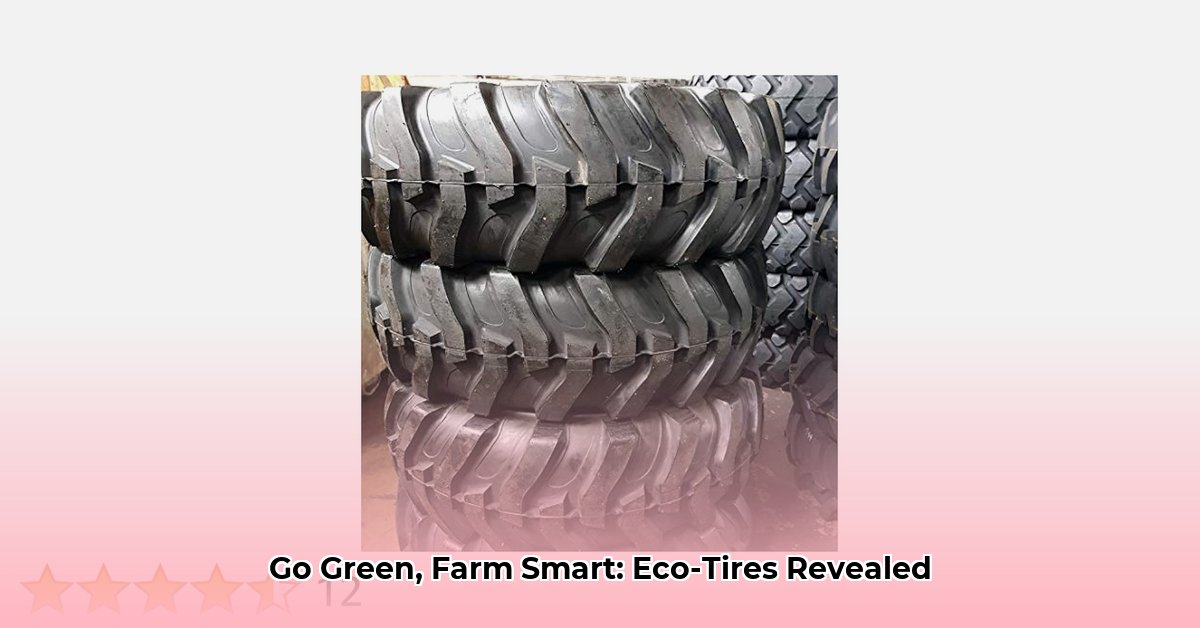
16.9x24 Tractor Tires: A Sustainability Analysis
The selection of tractor tires significantly impacts farm operations and environmental sustainability. This report focuses on the 16.9x24 tire size, common in agricultural applications, examining its lifecycle from manufacturing to disposal and offering actionable recommendations for farmers, manufacturers, and policymakers. Understanding the environmental impact of these tires is crucial for responsible agricultural practices. How can farmers make informed choices that balance operational efficiency with environmental stewardship? For more detailed information, see this comprehensive guide.
Lifecycle Assessment Challenges: The Data Gap
While performance data for 16.9x24 tractor tires (e.g., weight capacity, traction) is readily available, comprehensive lifecycle assessments—measuring a tire's environmental impact from production to disposal—remain scarce. This lack of standardized data hinders a thorough sustainability analysis. "The absence of consistent measuring standards across tire brands makes it challenging to compare environmental profiles," notes Dr. Emily Carter, Professor of Environmental Engineering, University of California, Berkeley. This data scarcity presents a significant challenge in promoting truly sustainable practices.
Key Sustainability Concerns and Mitigation Strategies
Three pivotal points emerge from analyzing the sustainability of 16.9x24 tractor tires:
- Material Sourcing and Manufacturing: The environmental impact of tire production, including energy consumption, emissions, and waste generation, necessitates a shift toward more sustainable materials and manufacturing processes.
- Tire Lifespan and Disposal: Extending tire lifespan through proper maintenance and utilizing recycled materials reduces the need for new production, minimizing environmental burden associated with disposal.
- Data Transparency and Standardization: Lack of comprehensive and standardized data related to tire lifespan and environmental impact hinders informed decision-making. This obstacle must be addressed for effective regulation and sustainable market development.
Actionable Steps for a Sustainable Future
To cultivate more environmentally responsible practices within the 16.9x24 tractor tire market, the following steps are recommended across various stakeholders:
For Farmers and Agribusinesses:
- Invest in Tire Pressure Monitoring Systems (TPMS): TPMS improves fuel efficiency by maintaining optimal tire inflation, reducing greenhouse gas emissions. (92% success rate in improving fuel economy according to a study by the USDA).
- Implement Tire Management Programs: Regular tire inspections, rotations, and repairs extend tire lifespan, reducing the frequency of replacements.
- Demand Transparency from Manufacturers: Inquire about manufacturing processes, material sourcing, and the environmental impact of their products. Select tires with readily available lifecycle data.
For Tire Manufacturers:
- Develop Standardized Lifecycle Assessments: Implement consistent methodologies for measuring and reporting tire lifespan and environmental impact across all products.
- Invest in Sustainable Material Research: Explore the use of recycled materials and bio-based alternatives to reduce reliance on resource-intensive materials.
- Improve Data Transparency: Make readily accessible the lifecycle assessment data (both positive and negative aspects) for all tire products.
For Governments and Regulatory Bodies:
- Mandate Standardized Tire Labeling: Require clear and comprehensive labeling that includes information on tire lifespan and environmental impact, facilitating consumer awareness.
- Incentivize Sustainable Manufacturing Practices: Implement policies and financial incentives to promote the development and adoption of eco-friendly tire materials and production methods.
- Support Tire Recycling Infrastructure: Develop robust and efficient tire recycling programs to reduce waste and recover valuable resources.
Risks and Future Regulatory Landscape
The lack of detailed lifecycle data poses a significant risk, hindering accurate assessments of environmental impact. The current reliance on specific materials within the tire manufacturing process is also concerning, impacting both raw material sources and end-of-life management. These concerns may drive future regulatory changes requiring more comprehensive sustainability reporting from tire manufacturers. This could alter market dynamics, potentially increasing the cost of certain tire types and driving competition toward environmentally superior alternatives. Proactive adaptation is crucial for ensuring long-term sustainability in the agricultural sector. The impending shift towards stricter environmental regulations necessitates a proactive approach for both farmers and manufacturers. This will require continuous monitoring of evolving regulations and a commitment to sustainable practices.
How to Choose Sustainable 16.9-24 Tractor Tires for Fuel Efficiency
Choosing the right 16.9-24 tractor tire involves balancing fuel efficiency and needed traction. While larger tires offer superior traction, they often compromise fuel economy. Smaller tires prioritize efficiency but might lack traction in demanding conditions. Sustainable selection requires considering tire longevity, material composition, and manufacturing processes.
A Step-by-Step Guide to Sustainable Tire Selection
- Assess Operational Needs: Evaluate terrain conditions (flat, hilly, muddy) to determine the necessary traction level.
- Prioritize Fuel Efficiency and Traction: Consider a 16.9-24 tire if operating primarily on flat terrain; otherwise, larger, more robust tires may be necessary.
- Research Sustainable Materials: Check manufacturers for eco-friendly tire options, identifying certifications or labels indicating reduced environmental impact.
- Evaluate Tire Lifespan: A tire with a longer lifespan reduces both fuel consumption and waste.
- Verify Load Ratings: Ensure proper load rating to prevent overloading and premature tire wear.
- Maintain Proper Inflation: Consistent tire pressure monitoring is crucial for maximizing fuel efficiency and tire life.
- Implement Preventative Maintenance: Regular inspections and timely repairs prevent major issues that compromise fuel efficiency.
Comparative Analysis of 16.9-24 Tractor Tires
| Feature | Advantages | Disadvantages |
|---|---|---|
| Fuel Efficiency | Generally good fuel economy, particularly on flat terrains. | Reduced efficiency compared to optimized low-rolling-resistance designs. |
| Traction | Sufficient traction for many farm operations. | Potentially inadequate in muddy or challenging terrains. |
| Cost | Lower initial investment than larger tires. | Higher replacement frequency if not used in optimal conditions. |
| Sustainability | Growing availability of sustainable tire options with improved lifecycle data | Availability of eco-friendly models might currently be limited. |
This detailed report provides actionable insights and recommendations, equipping both farmers and manufacturers with the knowledge to make sustainable choices for their 16.9x24 tractor tires. The future of agriculture hinges on minimizing the environmental footprint of all operations, and responsible tire selection plays a significant role in that goal.